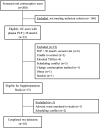Pyridoxine supplementation does not alter in vivo kinetics of one-carbon metabolism but modifies patterns of one-carbon and tryptophan metabolites in vitamin B-6-insufficient oral contraceptive users
- PMID: 26201817
- PMCID: PMC4548178
- DOI: 10.3945/ajcn.115.113159
Pyridoxine supplementation does not alter in vivo kinetics of one-carbon metabolism but modifies patterns of one-carbon and tryptophan metabolites in vitamin B-6-insufficient oral contraceptive users
Abstract
Background: Low chronic vitamin B-6 status can occur in a subset of women who use oral contraceptives (OCs) with uncertain metabolic consequences. An insufficiency of cellular pyridoxal 5'-phosphate (PLP), which is the coenzyme form of vitamin B-6, may impair many metabolic processes including one-carbon and tryptophan metabolism.
Objective: We investigated the effects of vitamin B-6 supplementation on the in vivo kinetics of one-carbon metabolism and the concentration of one-carbon and tryptophan metabolites in vitamin B-6-deficient OC users.
Design: A primed, constant infusion of [(13)C5]methionine, [3-(13)C]serine, and [(2)H3]leucine was performed on 10 OC users (20-40 y old; plasma PLP concentrations <30 nmol/L) before and after 28 d of supplementation with 10 mg pyridoxine hydrochloric acid/d. In vivo fluxes of total homocysteine remethylation, the remethylation of homocysteine from serine, and rates of homocysteine and cystathionine production were assessed. Targeted metabolite profiling was performed, and data were analyzed by using orthogonal partial least-squares-discriminant analysis and paired t tests adjusted for multiple testing.
Results: Pyridoxine supplementation increased the mean ± SD plasma PLP concentration from 25.8 ± 3.6 to 143 ± 58 nmol/L (P < 0.001) and decreased the leucine concentration from 103 ± 17 to 90 ± 20 nmol/L (P = 0.007) and glycine concentration from 317 ± 63 to 267 ± 58 nmol/L (P = 0.03). Supplementation did not affect in vivo rates of homocysteine remethylation or the appearance of homocysteine and cystathionine. A multivariate analysis showed a clear overall effect on metabolite profiles resulting from supplementation. Leucine, glycine, choline, cysteine, glutathione, trimethylamine N-oxide, and the ratios glycine:serine, 3-hydroxykynurenine:kynurenine, 3-hydroxykynurenine:3-hydroxyanthranilic acid, and 3-hydroxykynurenine:anthranilic acid were significant discriminating variables.
Conclusions: Consistent with previous vitamin B-6-restriction studies, fluxes of one-carbon metabolic processes exhibited little or no change after supplementation in low-vitamin B-6 subjects. In contrast, changes in the metabolic profiles after supplementation indicated perturbations in metabolism, suggesting functional vitamin B-6 deficiency. This study was registered at clinicaltrials.gov as NCT01128244.
Keywords: metabolomics; one-carbon metabolism; oral contraceptives; tryptophan catabolism; vitamin B-6.
© 2015 American Society for Nutrition.
Figures



Similar articles
-
Metabolite profile analysis reveals association of vitamin B-6 with metabolites related to one-carbon metabolism and tryptophan catabolism but not with biomarkers of inflammation in oral contraceptive users and reveals the effects of oral contraceptives on these processes.J Nutr. 2015 Jan;145(1):87-95. doi: 10.3945/jn.114.201095. Epub 2014 Nov 19. J Nutr. 2015. PMID: 25527663 Free PMC article. Clinical Trial.
-
The effect of vitamin B6 on cognition.Cochrane Database Syst Rev. 2003;(4):CD004393. doi: 10.1002/14651858.CD004393. Cochrane Database Syst Rev. 2003. PMID: 14584010
-
One-carbon metabolite supplementation increases vitamin B12, folate, and methionine cycle metabolites in beef heifers and fetuses in an energy dependent manner at day 63 of gestation.J Anim Sci. 2024 Jan 3;102:skae202. doi: 10.1093/jas/skae202. J Anim Sci. 2024. PMID: 39028746 Free PMC article.
-
Folic acid with or without vitamin B12 for cognition and dementia.Cochrane Database Syst Rev. 2003;(4):CD004514. doi: 10.1002/14651858.CD004514. Cochrane Database Syst Rev. 2003. Update in: Cochrane Database Syst Rev. 2008 Oct 08;(4):CD004514. doi: 10.1002/14651858.CD004514.pub2. PMID: 14584018 Updated.
-
Metabolite profile analysis reveals functional effects of 28-day vitamin B-6 restriction on one-carbon metabolism and tryptophan catabolic pathways in healthy men and women.J Nutr. 2013 Nov;143(11):1719-27. doi: 10.3945/jn.113.180588. Epub 2013 Aug 21. J Nutr. 2013. PMID: 23966327 Free PMC article.
Cited by
-
B Vitamins, Glucoronolactone and the Immune System: Bioavailability, Doses and Efficiency.Nutrients. 2023 Dec 20;16(1):24. doi: 10.3390/nu16010024. Nutrients. 2023. PMID: 38201854 Free PMC article. Review.
-
The acute postprandial response of homocysteine to multivitamin and mineral supplementation with a standard meal is not impaired in older compared to younger adults.Eur J Nutr. 2023 Apr;62(3):1309-1322. doi: 10.1007/s00394-022-03068-7. Epub 2022 Dec 20. Eur J Nutr. 2023. PMID: 36539620
-
Vitamin B6 nutritional status and cellular availability of pyridoxal 5'-phosphate govern the function of the transsulfuration pathway's canonical reactions and hydrogen sulfide production via side reactions.Biochimie. 2016 Jul;126:21-6. doi: 10.1016/j.biochi.2015.12.020. Epub 2016 Jan 4. Biochimie. 2016. PMID: 26765812 Free PMC article. Review.
-
Trimethylamine-N-oxide and its biological variations in vegetarians.Eur J Nutr. 2017 Dec;56(8):2599-2609. doi: 10.1007/s00394-016-1295-9. Epub 2016 Aug 25. Eur J Nutr. 2017. PMID: 27562778 Clinical Trial.
-
A novel nutritional supplement to reduce plasma homocysteine in nonpregnant women: A randomised controlled trial in The Gambia.PLoS Med. 2019 Aug 13;16(8):e1002870. doi: 10.1371/journal.pmed.1002870. eCollection 2019 Aug. PLoS Med. 2019. PMID: 31408467 Free PMC article. Clinical Trial.
References
-
- U.S. Center for Disease Control and Prevention. Second national report on biochemical indicators of diet and nutrition in the U.S. population. Atlanta (GA): Department of Health and Human Services; 2012.
-
- Morris MS, Picciano MF, Jacques PF, Selhub J. Plasma pyridoxal 5′-phosphate in the US population: the National Health and Nutrition Examination Survey, 2003-2004. Am J Clin Nutr 2008;87:1446–54. - PubMed
-
- Chiang EP, Bagley PJ, Selhub J, Nadeau M, Roubenoff R. Abnormal vitamin B(6) status is associated with severity of symptoms in patients with rheumatoid arthritis. Am J Med 2003;114:283–7. - PubMed
-
- Saibeni S, Cattaneo M, Vecchi M, Zighetti M, Lecchi A, Lombardi R, Meucci G, Spina L, de Franchis R. Low vitamin B(6) plasma levels, a risk factor for thrombosis, in inflammatory bowel disease: role of inflammation and correlation with acute phase reactants. Am J Gastroenterol 2003;98:112–7. - PubMed
Publication types
MeSH terms
Substances
Associated data
Grants and funding
LinkOut - more resources
Full Text Sources
Other Literature Sources
Medical
Research Materials
Miscellaneous

